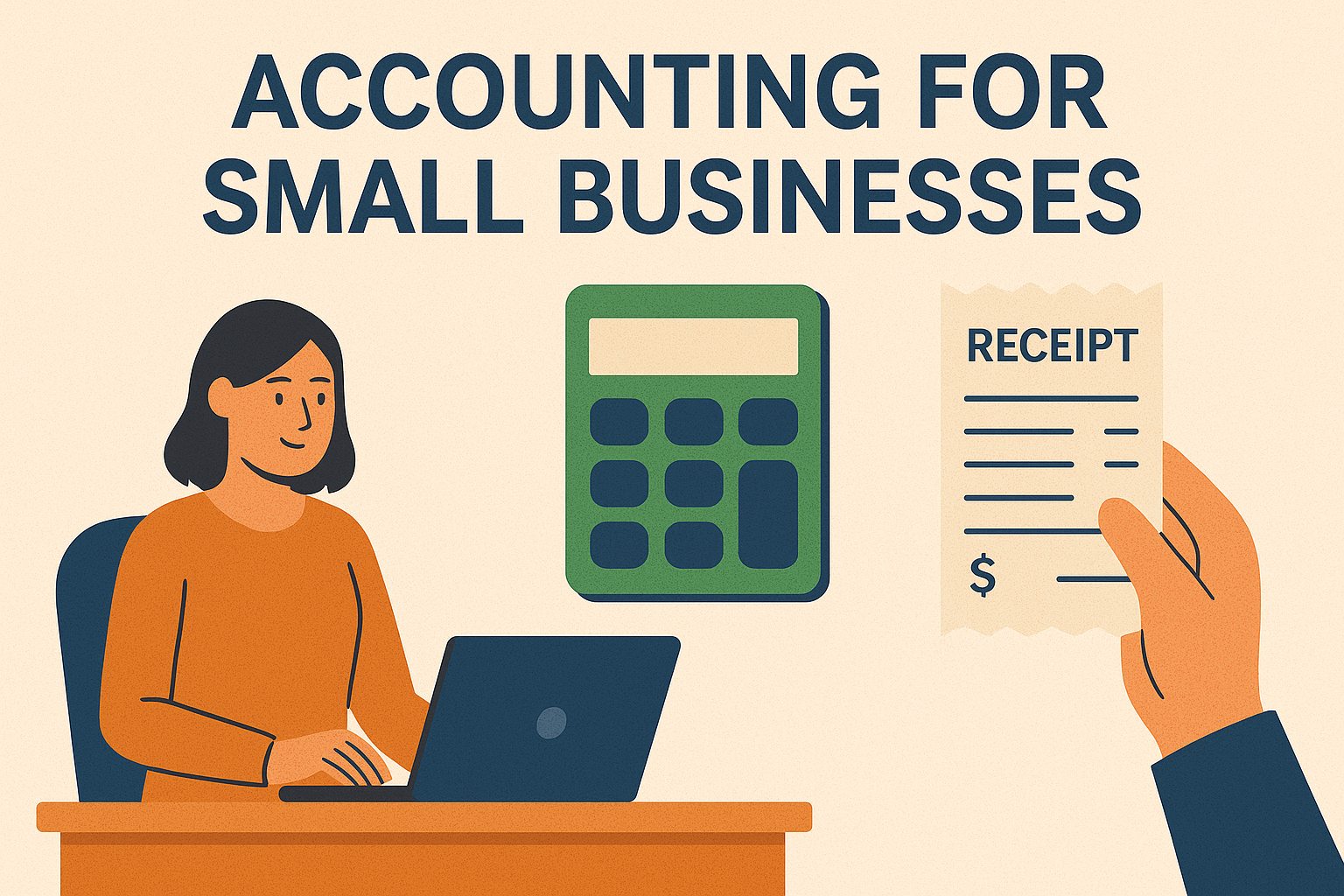Simple Accounting for Small Businesses in India
Introduction
Accounting is the backbone of every business—no matter how small. For Indian shopkeepers, Kirana store owners, local service providers, and startups, understanding basic accounting can make the difference between success and struggle. While many small business owners rely on instinct or verbal credit systems, maintaining accurate records can help track profits, avoid losses, and support loan or GST registration processes.
In this 1500-word guide, we explain simple accounting methods suitable for small businesses in India. We will cover why accounting is important, how to get started, tools you can use, and best practices to keep your finances clean, transparent, and growth-ready.
Why Is Accounting Important for Small Businesses?
Accounting helps you:
- Know your profit and loss
- Track sales and expenses
- Manage inventory and credit
- File taxes like GST
- Apply for bank loans and Mudra loans
Even if your business is small, accounting gives you control. It builds trust with banks, investors, and even your own employees.
Types of Small Businesses That Need Basic Accounting
- Kirana stores
- Mobile repair shops
- Garment sellers
- Tea stalls or snack centers
- Handicraft shops
- Tailors and boutiques
- Small manufacturers
- Digital service providers (graphic design, web dev)
If you handle money daily—you need accounting!
Basics of Accounting for Beginners
1. Income (Sales or Revenue)
This is the money you earn by selling goods or services.
Example: You sell groceries worth ₹1,000 in a day. That’s your income.
2. Expenses
Money spent on business operations:
- Product purchase
- Rent
- Electricity
- Salary or helper’s wages
- Packaging
- Transport
3. Profit or Loss
Profit = Income – Expenses
If income is more than expenses, you make a profit. If not, it’s a loss.
4. Inventory (Stock)
The products you keep in your shop to sell later.
Tracking inventory helps avoid overstocking or running out of items.
5. Receivables and Payables
- Receivables: Money customers owe you
- Payables: Money you owe suppliers
Use a simple ledger to track credits and payments.
Step-by-Step: Setting Up Basic Accounting for Your Business
Step 1: Maintain a Daily Sales Register
Use a notebook or Excel sheet to record:
- Date
- Product sold
- Quantity
- Price per item
- Total sale
Example:
| Date | Item | Quantity | Rate | Total |
|---|---|---|---|---|
| 01-Jul | Biscuits | 10 | ₹5 | ₹50 |
Step 2: Record Daily Expenses
Make note of:
- Rent (monthly)
- Purchase of goods
- Electricity
- Petty cash (tea, repairs, dusters, etc.)
Step 3: Use a Ledger Book or App
Maintain two separate accounts:
- Customer Ledger (Khata)
- Supplier Ledger
Record credit and payment entries clearly.
Step 4: Calculate Weekly or Monthly Profit
Tally:
- Total income
- Total expenses
- Total inventory sold
Use the formula:
Profit = Sales – (Purchase Cost + Expenses)
Step 5: Store Bills and Receipts
Create a folder (digital or physical) for:
- Purchase bills
- Transport bills
- Electricity bills
- Rent receipts
These help during GST filing or audits.
Best Tools for Small Business Accounting in India
1. Vyapar App (Free & Paid)
- Invoice and billing
- Stock tracking
- Profit-loss reports
- Supports GST
2. KhataBook / OKCredit
- Record customer credit
- Send payment reminders via WhatsApp
- Good for small stores
3. TallyPrime (Advanced Users)
- Used by CA firms
- Ideal if you have an accountant
4. Google Sheets / Excel
- Customizable
- Simple to use for calculations
Examples of Basic Accounting Entries
Income Entry:
- 05-Jul: Sold milk, ₹2,000
- 05-Jul: Sold biscuits, ₹500
- Total: ₹2,500
Expense Entry:
- Bought groceries from wholesaler: ₹1,200
- Transport cost: ₹100
- Electricity: ₹500
Profit Calculation:
₹2,500 – (₹1,200 + ₹100 + ₹500) = ₹700 profit
Tax and Compliance
1. GST Filing
- If annual turnover > ₹40 lakhs (₹20 lakhs in services), GST registration is mandatory.
- Maintain monthly invoices and file GSTR-1 and GSTR-3B
2. Income Tax
- If annual profit > ₹2.5 lakhs, file income tax return (ITR-4 for presumptive tax)
3. Shop Act and Trade Licenses
Keep accounting records to show at time of renewal or inspection.
How to Handle Credit Transactions
Many Indian small businesses give or take goods on credit. This is risky if not recorded properly.
Tips:
- Always note credit entries with date and amount
- Use a mobile app to set payment reminders
- Avoid giving large credits without documentation
- Collect payments weekly or fortnightly
Inventory and Accounting
Stock control is part of accounting.
Maintain:
- Opening stock (start of month)
- Purchases during the month
- Sales (billed or sold)
- Closing stock (end of month)
Formula:
Closing Stock = Opening Stock + Purchases – Sales
This helps identify:
- Fast-moving items
- Slow-moving or dead stock
- Theft or loss
Accounting for Seasonal Businesses
Some businesses (ice cream stalls, crackers, umbrellas) run only during a few months.
Suggestions:
- Track income and expense season-wise
- Maintain savings for off-season
- Use seasonal profits to invest in stock or business growth
Digital vs. Manual Accounting
| Feature | Manual (Notebook) | Digital (Apps/Excel) |
| Cost | ₹0–100 | Free to low cost |
| Accuracy | Medium | High |
| Speed | Slow | Fast |
| Reports | Manual | Auto-generated |
| Backup | Paper only | Cloud or mobile backup |
Use digital tools if possible. They are easier to manage and offer better analysis.
Case Study: Meena’s Boutique in Varanasi
Problem: Meena was losing track of customer payments, especially for stitching orders.
Solution:
- Started recording each order in a ledger
- Used Google Sheets to track income and fabric costs
- Sent reminders using WhatsApp with order totals
Result:
- Monthly income increased by ₹5,000
- Reduced unpaid bills by 80%
Common Accounting Mistakes to Avoid
1. Mixing Personal and Business Expenses
Use separate notebooks or bank accounts.
2. Not Recording Daily Sales
Relying on memory leads to errors.
3. Forgetting to Collect Receivables
Set reminders and keep follow-ups
4. Delaying GST Filing
You may face penalties. File on time.
Monthly Accounting Checklist
✅ Record daily sales and expenses
✅ Update stock/inventory once a week
✅ Track receivables and follow up
✅ Reconcile cash and bank balance
✅ Calculate monthly profit/loss
✅ Save all bills and receipts
Conclusion
Accounting may sound boring, but for small business owners in India, it’s a powerful tool. With just 15–20 minutes a day, you can understand your business better, avoid losses, and grow faster.
Start simple: maintain sales and expense records, track credit, and use a free mobile app. As your business grows, move to more detailed systems or hire a part-time accountant.
In today’s digital age, accounting is not optional—it’s essential. Take the first step today, and watch your business grow with confidence and clarity.



